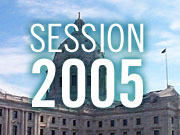Audio
Photos
More from MPR
Resources
| |||||||||||||||||||||||||||||||
June 27, 2005
As a partial government shutdown looms closer, hospitals and other health care providers are concerned they may be forced to play a greater role in caring for the state's vulnerable. If Gov. Pawlenty and legislative leaders don't reach agreement on several budget items, a partial government shutdown will begin on July 1. People on state-subsidized insurance will still be able to seek treatment. But it may be more difficult, because services that help them navigate the health care system will be mothballed.
St. Paul, Minn. — Even though a judge ruled that core government functions should continue in the event of a government shutdown, that doesn't mean all state services will run on auto-pilot. Thousands of state employees are waiting for their pink slips. And a shutdown will also force several non-profits to lay people off. Tova Sularz could be one of them.
"It's concerning, as in anytime when you're thrown into a market that's continuously harder and harder to find work. It does worry all of us," says Sularz.
Sularz is one of seven community health care workers for the Neighborhood Health Care Network. One week before the scheduled shutdown, Sularz was helping people navigate the complex state health insurance application at the Sheridan Women's and Children's Clinic in northeast Minneapolis.
In one corner of the building, Sularz and others process applications. On the other end, patients wait for their treatment.
Many of the clients who work with Sularz speak little or no English. Others need help knowing which program fits them best.
The money that funds Sularz' job is dependent on a $265,000 state contract which ends on June 30. If a budget deal isn't reached, Sularz' salary dries up.
She says she's worried about her own financial well being, but is also concerned that those who need help navigating an often complex medical system will be left without a guide.
"We don't know whether or not to tell our clients that we will be there to help them through this process," says Sularz. "How much of the process we have to have them try to do on their own, or even if there will be a program for them to apply to."
The Department of Human Services says people on MinnesotaCare, Medical Assistance and General Assistance medical care will continue to receive care as long as they continue to pay their premiums. But Human Services Commissioner Kevin Goodno says the state will not accept any new MinnesotaCare applications after July 1.
Goodno says his department is asking doctors, hospitals and other health care providers to continue treating patients on state health programs. He says the state will pay some critical care providers, but others will be forced to wait until a budget deal is reached.
"We're asking them to continue to provide services on the hope that at some point, we will get a resolution to the budget process and they will eventually get paid," says Goodno.
The request puts some doctors in a precarious position, since their bottom line may bottom out if a shutdown lasts several weeks. Don Jacobs is a trustee of the Minnesota Medical Association and CEO of Hennepin Faculty Associates at Hennepin County Medical Center. He says doctors and clinics who focus on treating the low income and working poor will be faced with a cash flow crunch if a shutdown occurs.
"We have an ethical responsibility for the care of our patients, and we will meet that obligation," says Jacobs. "But there becomes a limit to the financial viability of practices, particularly when a very large portion of their practice revenues may come from those patients and the type of programs that are supported by the public money."
Hennepin County Administrator Sandy Vargas says any confusion caused by a shutdown could also increase admission rates at Hennepin County Medical Center. She says patients may forego their traditional clinics because they don't want to wait in long lines, or are worried that they're no longer eligible for insurance.
She says some doctors may refuse to see any patients on government assistance until the shutdown is over. With nowhere else to go, those patients could end up in emergency rooms across the state.
"As much as I think providers are committed to serving, at some point they may have to look at their bottom line and make a decision," says Vargas. "We don't know if that's what will happen, but that's the risk analysis that we're looking at."
Vargas and other county administrators across the state say they're still trying to figure out what other services may be at risk. They say they won't know the full impact of the shutdown until it occurs.






